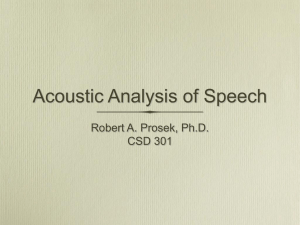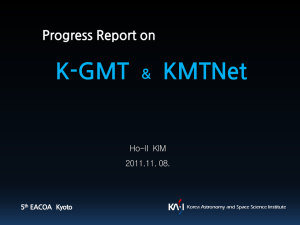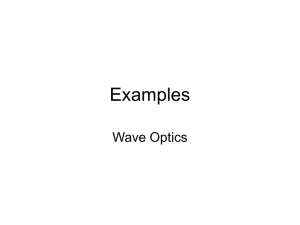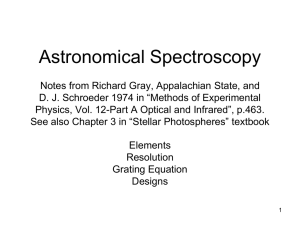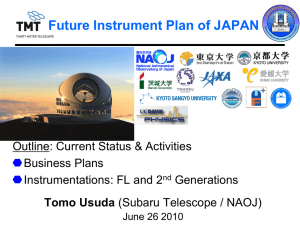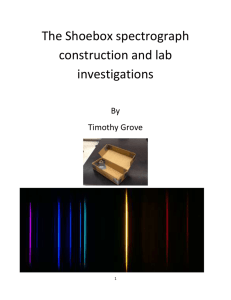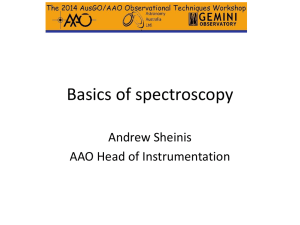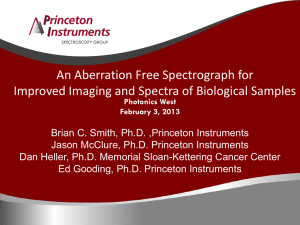A Student assembled spectrograph with CCD detector to
advertisement
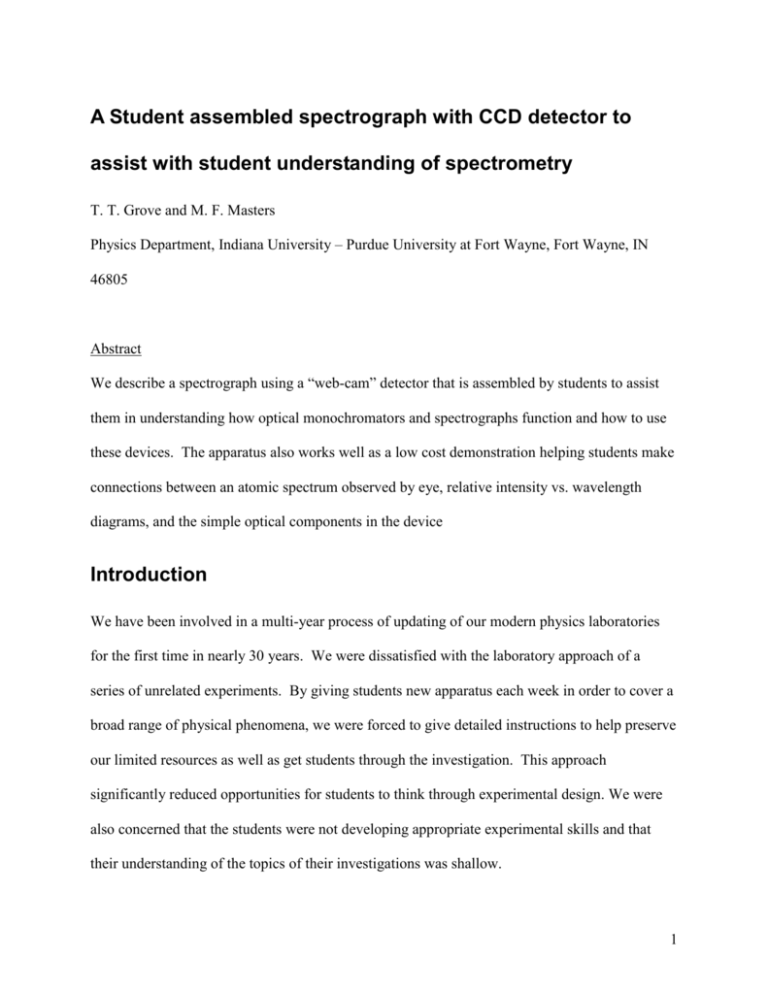
A Student assembled spectrograph with CCD detector to assist with student understanding of spectrometry T. T. Grove and M. F. Masters Physics Department, Indiana University – Purdue University at Fort Wayne, Fort Wayne, IN 46805 Abstract We describe a spectrograph using a “web-cam” detector that is assembled by students to assist them in understanding how optical monochromators and spectrographs function and how to use these devices. The apparatus also works well as a low cost demonstration helping students make connections between an atomic spectrum observed by eye, relative intensity vs. wavelength diagrams, and the simple optical components in the device Introduction We have been involved in a multi-year process of updating of our modern physics laboratories for the first time in nearly 30 years. We were dissatisfied with the laboratory approach of a series of unrelated experiments. By giving students new apparatus each week in order to cover a broad range of physical phenomena, we were forced to give detailed instructions to help preserve our limited resources as well as get students through the investigation. This approach significantly reduced opportunities for students to think through experimental design. We were also concerned that the students were not developing appropriate experimental skills and that their understanding of the topics of their investigations was shallow. 1 For these reasons we developed a new laboratory sequence involving “tracks” of closely related experiments. Any individual student would follow a particular track through the entire laboratory. All of the tracks have the goal of making the students learn some aspect of modern physics, experimental techniques, and to help the students develop a level of independence in performing an experiment. One of these tracks is titled spectroscopy. The purpose of this track is to bring the students to an understanding of atomic and molecular structure and to develop their experimental abilities in spectroscopy. The ultimate goal of this sequence has been an investigation of laser induced fluorescence of the Cs21 molecule to determine the vibrational constant of the ground state through analysis of the spectrally resolved vibrational transitions. Students start this sequence of investigations using a simple grating spectroscope which involves a slit, collimating lens, diffraction grating, and telescope. They observe by eye the spectra from various atomic discharge lamps and must identify an unknown element from its spectrum. In our original sequence, the students would then use a ½ meter commercial spectrograph. First using the atomic discharge lamp sources and then laser induced fluorescence. This sequence turned out to be problematic because the students did not have any idea how to use the commercial spectrograph. Even with detailed directions, the students often struggled and were unable to determine how to properly couple light into the spectrograph. The detailed directions simply kept the students from thinking about how to use the spectrograph as well as how it functions. Adding more detailed directions was in contradiction to our laboratory philosophy. We needed an investigation to foster the necessary skills so that students can reason through the proper alignment of a commercial ½ m spectrograph or monochromator effectively to observe the faint laser induced fluorescence 2 The spectrograph is a complicated device which the students wish to treat as a “black box.” To effectively use a spectrograph, one must understand the functioning of the internal components. However, understanding the internal components individually does not completely assist in understanding how the device functions as a whole because the impacts of the individual components on the whole device are intertwined. In the course of the laboratory sessions we queried the students about the success or failure of their investigation. We then identified multiple mis-concepts in regard to student’s understanding of the spectrograph: the purpose of the entrance slit; the benefit of illuminating most of the grooves on a diffraction grating; the importantance of the spacing of the optical elements; optimizing both light throughput and resolution; and calibration of the completed spectrograph to determine unknown wavelengths. The students in our modern physics laboratory are familiar with geometrical and physical optics. The students were given a schematic picture of the spectrograph and they were allowed to remove the case to observe the optical components inside the device. However, there is a significant difference between familiarity and understanding. We found that the students often had a shallow understanding of each individual optical element, but they did not consider how all the optical elements worked together as a whole. For example, if the signal was weak, students simply saw this as a device limitation no matter how poorly the light was coupled into the spectrograph. If we pointed out that a great deal of light was not entering the initial slit, students would focus the light through the entrance slit with no consideration given to the illumination of optical elements behind the slit. If we stated that the resolution could be improved by illuminating more of the diffraction grating, students would open the entrance slit never realizing that this action was counter-productive. 3 To address all of these issues we felt it was necessary for the students to see, touch and adjust the internal workings of a spectrograph and try various adjustments of the spectrograph and observe the impact. This would allow the students to directly examine the effect of optical coupling of light into the device and how it impacts resolution. For obvious reasons we do not want the students dismantling our precision commercial apparatus. Therefore, we decided that it would be beneficial for the students to build their own spectrographs on an optical breadboard. Our design requirements on the spectrograph are that it be low-cost and rugged. We want to have sensors and optical elements that are affordable. We chose a spectrograph rather than a monochromator for several reasons. First, we wanted the students to see a familiar spectrum that they first observed with a spectroscope. Second, since a spectrograph does not require a rotation stage to move the grating, it is more affordable. By building a spectrograph, the students directly observe the impacts of filling the diffraction grating, optically coupling the light into the monochromator and issues of misalignment. The conversion of a color image of the spectrum to a chart of relative intensity vs. wavelength assists the students on making the abstract association of the spectrum to the plot of the spectrum. The questions we want the students to address through construction of the spectrograph are: How do you maximize the optical throughput of the device given a light source located an arbitrary distance away? How do you increase the resolution of the device? What impact does entrance slit-width have on the resolution? What impact does filling the grating have on resolution? How do you calibrate the device? What does the output of the device mean? 4 Project and results The student-built spectrograph is assembled on an optical breadboard in a basic Czerny-Turner2 optical layout as shown in figure 1. The slits can be made by gluing razor blades to a pair of Vernier calipers or they may be purchased. Light originating at the slit is collimated using a 160 mm focal length concave spherical mirror. The mirror is masked to the same size as the grating to assist in alignment. We use a 150 groove/mm grating blazed at 500 nm so that we can collect a broad spectrum with a small sensor. A second 160 mm focal length spherical mirror images the entrance slit on the detector. We chose to use a “web-cam” as the detector because it is a very affordable, robust, camera that is easily interfaced to a computer. Webcams also provide the ability for observation of the images in realtime providing instant feedback for adjustments of the optical components. National Instruments recently released LabView libraries that allow image acquisition from USB based “web-cams” makes using “web-cams” even more convenient.3 For the present work we are using a Logitech Quickcam with the lens removed. It provides a resolution of 640 x 480 pixels with an approximate area of 0.25 cm2. Once the lens is removed, the camera is reassembled and the housing is glued to a standard optic post. There have been several articles on the use CCD camera detection for optics experiments4,5,6. The devices used in these articles have varied from linear arrays from scanners to digital cameras. We desired to image the entire visible spectrum on the camera . Since the camera’s sensor is small, we would have to use a short focal length mirror. However, a short focal length made the distances between the mirror and the camera so small that alignment became impossible (the web-cam’s dimensions blocked necessary optical paths) without introducing significant 5 aberrations in the image. We relieved this issue by using another auxiliary lens (75 mm focal length, 25 mm diameter). The inclusion of the lens results in less uniform spectral lines due to aberrations introduced by the lens (see Figures 2 and 3). However, we do not believe these aberrations are significant given the purpose of this device is to familiarize students with the optical workings of a spectrometer as opposed to research quality data (which can be obtained from our commercial spectrometer). The most efficacious method we have found to have the students learn about a spectrograph, how to align it and use it, and about how the various components contribute to the whole is to allow students to make discoveries about the slits, grating, optical coupling for themselves. At the start of the investigation, we provide students with a number of questions which they must attempt to answer as part of their final report. Following our laboratory philosophy, we do not give specific step by step instructions. Rather, the instructions are intentionally vague so that students must solve problems before proceeding. The first problem students must solve is determining the optimal location of the concave mirror (in reference to a small light source) so that optimal light power is sent to a distant light detector. Students are given a photodiode (Pin 10D), a light source, and a curved mirror. Frequently, students fail to realize that this is basically an imaging problem akin to second semester physics. Whether students immediately see the solution or have to find it experimentally, we insist that students explain why they have selected a particular separation between the mirror and the light source before continuing. During these discussions, we often probe student’s knowledge and ask leading questions regarding the mirror’s focal length. Students then illuminate the grating with 6 collimated light and observe what happens to the light. Finally, students complete the setup by re-imaging the light from the grating onto the detector producing an image of the small source. Once the students have assembled and aligned the spectrograph, they investigate how to couple light into to the spectrograph to achieve the optimal light throughput and resolution (achieve narrow line width and good signal to noise). To assist the students in understanding the components within the spectrograph and the alignment and use of a spectrograph and to assist in visualizing the meaning of the spectral power distribution we developed a LabView program7 similar to that of Ref. Error! Bookmark not defined.. This software continuously acquires an image and converts it into a spectrum plot of relative intensity vs. pixel number in real time by averaging the columns of the image. The ability to view both images and spectrum plot simultaneously allows the students to directly observe the impact of detector rotation, placement, width of the slits and number of grooves illuminated, and how rotation of the grating moves the image on the detector. Additionally, because the images are in color, the students have an easier time relating the plot of relative intensity as a function of wavelength with line spectra, a task that can be difficult. When confronted with the issue of how to best couple the light into the spectrograph to achieve the best signal to noise and highest resolution, most often students respond by placing the light source as close to the slits as possible. As the spectrograph is completely open, students can readily observe the spectrum, how much of the grating is filled and the general optical performance of the device. Students are encouraged to back the light source away from the slit and use a lens (auxiliary lens 1 in Fig. 1) to image the source on the slits. Now students can 7 attempt to fill more and more of the grating and observe what happens with the spectrum. As part of the final report, students are required to make ray drawings for the entire device. Typical data from a helium discharge lamp is shown in Fig. 2. Then based on user controlled input values of peak threshold and typical pixel peak width, the program returns peak locations, peak amplitudes, and the peak’s half width half max (peak location and HWHM are given in terms of pixel number). The program also returns a fit based on the calculated peak locations, amplitudes, and widths (assuming Lorentzian line profiles). Using a variety of atomic sources and plotting the wavelength vs. pixel number, we form the calibration curve shown in Fig. 3. Unlike a monochromator, the images are more or less correctly colored (see below note) which allows correspondence with the students’ observations using the spectroscopes. Note: the webcam does not accurately display colors seen by eye for wavelengths approaching the near infrared and ultraviolet regions but it is acceptable for most of the visible spectrum. We have also found that this apparatus also works well for demonstrations. The web-cam can take live pictures on a computer which can be projected on a large screen. Furthermore, as the entire apparatus is made of components that are usually studied before spectra in second semester physics classes; it allows students to see how the spectra are generated and how to interpret the diagrams. Conclusion We have developed a low cost, student built spectrograph which prepares students to use commercial spectrographs and monochromators more effectively. Additionally, the device is 8 useful for demonstrations allowing spectra to be displayed (via computer projection equipment) on a screen for an entire class and allows these students to see and modify what is inside of the spectrograph. This work was partially funded by NSF CCLI grant 0127078. 9 Webcam Auxiliary Lens 2 150 lines/mm Grating Light Source Auxiliary Lens 1 R=160mm Concave Spherical mirrors Adjustable slit 10 Intensity (arb) 250 200 150 100 50 0 0 100 200 300 400 500 600 pixel number 11 Wavelength (nm) 700 650 600 550 500 450 400 0 100 200 300 400 500 600 pixel number 12 Figure Captions 1. Experimental setup for our spectrograph. Light from a spectral source is focused through an auxiliary lens (in our setup we used a 25mm FL, 25 mm diameter planoconvex lens) through a slit. Then a concave spherical mirror (R = 160mm, 50 mm. 75 mm.) focuses the image at infinity. Ideally, one wants a tight focus through the slits and the collimated light should fill the grating. The grating was a 150 gr/mm diffraction grating with dimensions of 10 mm x 50 mm. The light from the grating is then focused on the webcam (with lens removed) by another concave spherical mirror (same specifications as previous) and an optional lens (for the data in the next figures we used a 75mm FL, 25 mm. diameter, plano-convex lens). The dotted lines around represent a cardboard enclosure which minimizes stray light from entering our spectrometer. The cardboard enclosure also encloses our spectrometer much like the case of a commercial spectrometer. 2. An example helium spectra using our webcam based spectrograph. The peaks have a FWFM smaller than 3nm. 3. Wavelength vs. pixel locations for 4 different atomic samples. - He data, - Ne data, - H data, and - Hg data. The uncertainty bars for all the data is much smaller than the size of the data markers. The line passing through the data has a slope of (0.414 0.004) nm/pixel and an intercept value of (430.5 1.8) nm. It is 13 important to realize that the slope and intercept values are highly dependent of the physical location of mirrors and lenses. Without the second auxiliary lens, the region of the visible spectrum observed is reduced so that the HWHM of individual peaks is smaller. These values were included to help demonstrate the accuracy of the spectrograph when most of the visible spectrum is spectrum fits across the camera’s active region. 14 1 Mark Terrell and Mark F. Masters, “Laser Spectroscopy of the cesium dimer as a physics laboratory experiment”, Am. J. Phys. 64, 1116 – 1120 (1996). 2 Introduction to Optics, 2e, Frank L. Pedrotti, S.J., Leno S. Pedrotti,, Prentice Hall, 1993. 3 Available from National Instruments: www.ni.com. Search for IMAQ USB. 4 C. de Izara and O. Vallee, “On the use of linear CCD image sensors in optics experiments,” Am. J. Phys. 62, 357 – 361 (1994). 5 C. Lengacher, S. Macklin, D. Hite, and M. F. Masters, “Low cost CCD detectors for spectroscopy,” Am. J. Phys. 66, 1025 – 1028 (1998). Mauizio Vannoni and Giuseppe Molesini, “Speckle Interferometry experiments with a digital photo camera,” Am. J. Phys. 72, 906-909 (2004). 6 7 To download a copy of this program, go to http://users.ipfw.edu/grovet/spectrostud.htm 15

